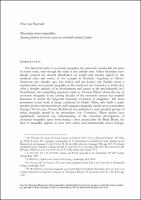Chapter Measuring urban inequalities. Spatial patterns of service access in sixteenth-century Leiden
| dc.contributor.author | van Steensel, Arie | |
| dc.date.accessioned | 2022-06-01T12:11:54Z | |
| dc.date.available | 2022-06-01T12:11:54Z | |
| dc.date.issued | 2020 | |
| dc.identifier | ONIX_20220601_9788855180535_221 | |
| dc.identifier.uri | https://library.oapen.org/handle/20.500.12657/56038 | |
| dc.description.abstract | This contribution develops a broader understanding of well-being in premodern towns and by using digital methods to map social and economic inequalities, thereby drawing on insights from research on socio-spatial equity from urban studies. The key questions are how socio-economic inequality was reflected in the urban social topography and to what extent these spatial patterns reproduced inequality. Taking sixteenth-century Leiden as a case study, the spatial patterns of economic inequality and social segregation in this town are first examined. Next, the level of location-based inequality is explored by mapping and calculating urban spatial patterns of service accessibility. | |
| dc.language | English | |
| dc.relation.ispartofseries | Datini Studies in Economic History | |
| dc.subject.other | economic inequality | |
| dc.subject.other | economic history | |
| dc.subject.other | low countries | |
| dc.subject.other | leiden | |
| dc.subject.other | pre-industrial age | |
| dc.title | Chapter Measuring urban inequalities. Spatial patterns of service access in sixteenth-century Leiden | |
| dc.type | chapter | |
| oapen.identifier.doi | 10.36253/978-88-5518-053-5.24 | |
| oapen.relation.isPublishedBy | bf65d21a-78e5-4ba2-983a-dbfa90962870 | |
| oapen.relation.isbn | 9788855180535 | |
| oapen.series.number | 1 | |
| oapen.pages | 20 | |
| oapen.place.publication | Florence |

